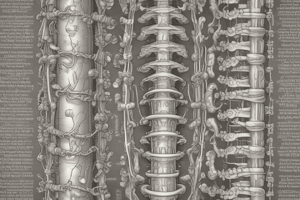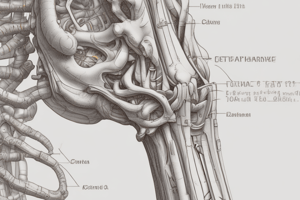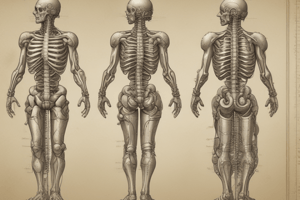Podcast
Questions and Answers
The ligamentum flavum primarily limits forward flexion in the lumbar area.
The ligamentum flavum primarily limits forward flexion in the lumbar area.
True (A)
The tectorial membrane is thickest in the cervical region.
The tectorial membrane is thickest in the cervical region.
False (B)
Posterior atlantoaxial ligament is a continuation of the anterior longitudinal ligament.
Posterior atlantoaxial ligament is a continuation of the anterior longitudinal ligament.
False (B)
Supraspinous ligaments are primarily found in the cervical region.
Supraspinous ligaments are primarily found in the cervical region.
Anterior longitudinal ligament limits extension and reinforces the anterolateral portion of the intervertebral joints.
Anterior longitudinal ligament limits extension and reinforces the anterolateral portion of the intervertebral joints.
The anulus fibrosus is reinforced by the anterior longitudinal ligament.
The anulus fibrosus is reinforced by the anterior longitudinal ligament.
The main requirements for the function of the vertebral column include rigidity and elasticity.
The main requirements for the function of the vertebral column include rigidity and elasticity.
The rigidity of the vertebral column is compared to a ship's mast extending from the pelvis to the head.
The rigidity of the vertebral column is compared to a ship's mast extending from the pelvis to the head.
Plasticity in the vertebral column refers to the ability to maintain a fixed shape regardless of external forces.
Plasticity in the vertebral column refers to the ability to maintain a fixed shape regardless of external forces.
The muscular tighteners in the vertebral column do not play a role in restoring equilibrium.
The muscular tighteners in the vertebral column do not play a role in restoring equilibrium.
At shoulder level, the vertebral column supports a main-yard set horizontally, enhancing stability.
At shoulder level, the vertebral column supports a main-yard set horizontally, enhancing stability.
Pure lateral flexion and pure rotation can occur in some regions of the spine.
Pure lateral flexion and pure rotation can occur in some regions of the spine.
Spinal coupling involves movement in only one plane.
Spinal coupling involves movement in only one plane.
Coupling movements primarily involve lateral flexion and contralateral axial rotation in the lower cervical spine.
Coupling movements primarily involve lateral flexion and contralateral axial rotation in the lower cervical spine.
During primary lateral bending, there is contralateral axial rotation in the thoracic spine.
During primary lateral bending, there is contralateral axial rotation in the thoracic spine.
The smallest functional unit in the spine consists of a single vertebra and the intervertebral disk.
The smallest functional unit in the spine consists of a single vertebra and the intervertebral disk.
The mechanics of spinal coupling can be influenced by factors such as muscle action and rib attachment.
The mechanics of spinal coupling can be influenced by factors such as muscle action and rib attachment.
Prolonged compressive forces can lead to a shift in load from the annulus fibrosus to the nucleus pulposus.
Prolonged compressive forces can lead to a shift in load from the annulus fibrosus to the nucleus pulposus.
Torsional forces are not a part of the coupled motions during axial rotation.
Torsional forces are not a part of the coupled motions during axial rotation.
The inner layers of the vertebral bodies and intervertebral disks provide torsional stiffness.
The inner layers of the vertebral bodies and intervertebral disks provide torsional stiffness.
All annulus fibrosus fibers resist torsional rotations in the same direction.
All annulus fibrosus fibers resist torsional rotations in the same direction.
Shear forces tend to cause each vertebra to move superiorly or inferiorly.
Shear forces tend to cause each vertebra to move superiorly or inferiorly.
In the lumbar spine, the disks resist all shear forces.
In the lumbar spine, the disks resist all shear forces.
The risk of injury is highest when rotational forces are combined with compressive and extension forces.
The risk of injury is highest when rotational forces are combined with compressive and extension forces.
The ligamentum nuchae limits flexion motions.
The ligamentum nuchae limits flexion motions.
The interspinous ligaments limit lateral flexion in the lumbar region.
The interspinous ligaments limit lateral flexion in the lumbar region.
The anterior annulus fibrosus limits extension motions.
The anterior annulus fibrosus limits extension motions.
The alar ligament limits axial rotation in the lumbar region.
The alar ligament limits axial rotation in the lumbar region.
Flashcards are hidden until you start studying
Study Notes
Mechanical Changes in the Disk
- Prolonged forces can cause mechanical changes in the disk, resulting in creep loading, which affects the neural arch and ligaments, especially the apophyseal joints.
- This leads to large compressive and bending forces on the neural arch and ligaments.
Effects of Creep Loading
- Creep loading causes a shift in load from the nucleus pulposus to the annulus fibrosus, especially the posterior aspects.
- This increased load can cause buckling or prolapse of the annulus fibrosus.
- Elongation of the supporting structures due to creep leads to a lack of stability and places the vertebral structures at risk of injury.
Torsional Forces
- Torsional forces are created during axial rotation, which is a part of the coupled motions.
- The highest torsional stiffness is found at the thoracolumbar junction.
- Torsional stiffness is provided by the outer layers of both the vertebral bodies and intervertebral disks, and by the orientation of the facets.
- Half of the annulus fibrosus fibers resist clockwise, and the other half resist counterclockwise rotations.
Shear Forces
- Shear forces act on the midplane of the disk and tend to cause each vertebra to move anteriorly, posteriorly, or from side to side in relation to the inferior vertebra.
- In the lumbar spine, the apophyseal joints resist some of the shear force, while the disks resist the remainder.
The Vertebral Column
- The vertebral column requires both rigidity and plasticity to function.
- Rigidity is necessary for maintaining structure and stability, while plasticity allows for adaptation and movement.
- The vertebral column can be thought of as a ship's mast, with ligamentous and muscular tighteners acting as stays to maintain its shape.
Coupling Movements
- Movement of the vertebral column in one plane is usually associated with an automatic and nearly imperceptible movement in another plane.
- This phenomenon is called spinal coupling.
- Pure lateral flexion and pure rotation do not occur in any region of the spine.
- Coupling patterns involve an association between lateral flexion and ipsilateral axial rotation in the middle and lower cervical spine.
Ligamentous Support
- Ligaments provide support to the spine by resisting distraction, translation, and rotation of vertebral bodies.
- Different ligaments have specific functions and regions of influence, including:
- Anulus fibrosus (outer fibers)
- Anterior longitudinal ligament
- Posterior longitudinal ligament
- Ligamentum flavum
- Posterior atlantoaxial ligament
- Supraspinous ligaments
- Interspinous ligaments
- Ligamenta flava
Conective Tissues that Limit Motions
- Flexion is limited by ligamentum nuchae, interspinous and supraspinous ligaments, ligamenta flava, capsule of the apophyseal joints, posterior annulus fibrosus, and posterior longitudinal ligament.
- Extension is limited by cervical viscera (esophagus and trachea), anterior annulus fibrosus, and anterior longitudinal ligament.
- Lateral flexion is limited by intertransverse ligament (lumbar region), contralateral annulus fibrosus, and contralateral capsule of the apophyseal joints.
- Axial rotation is limited by alar ligament (craniocervical region), annulus fibrosus, and capsule of the apophyseal joints
Studying That Suits You
Use AI to generate personalized quizzes and flashcards to suit your learning preferences.




